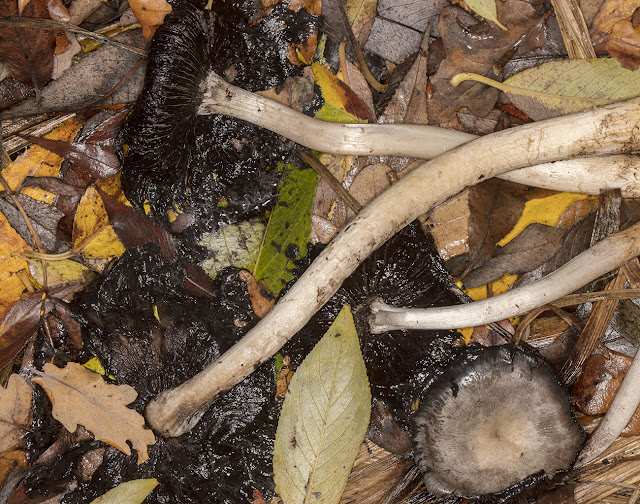 |
| Coprinopsis atramentaria, Common Inkcap. Hayes Common, 18 November 2016. |
Fungi are often not easy to see until you train your perception into looking for the right things. For example, recently I looked into a hollow on my local common that contains a pond. I saw some interesting things straight away, but it wasn't until I went back and walked around looking carefully that I saw other, quite large fungi.
 |
| Coprinopsis atramentaria, Common Inkcap. Hayes Common, 18 November 2016. |
If you weren't looking down you might walk right past these. Although they are called Common Inkcaps, I have not seen this species before. These are growing in part of the hollow that is usually underwater.
They are called Inkcaps because ...
 |
| Coprinopsis atramentaria, Common Inkcap. Hayes Common, 13 November 2016. |
When they mature, they produce jet black spores and dribble them out in lots of fluid, which was actually once used as ink.
It's possible for quite colourful fungi to be disguised too, among the yellows and browns of leaf litter.
 |
| Gymnopilus penetrans, Common Rustgill. Hayes Common, 16 November 2016. |
On a stump in the same hollow is this Rustgill, and I had to step up close to be sure I was seeing what I thought I was.
 |
| Gymnopilus penetrans, Common Rustgill. Hayes Common, 16 November 2016. |
Up close it looks impossible to disguise, but it's a very similar colour to some of the Oak leaf litter that surrounds it.
Here is the hollow ...
 |
| Logs and pond on Hayes Common, 18 November 2016. |
That colourful Rustgill is on the low stump in the left close foreground. (The Inkcaps are to the left of the mound in the background.)
There are some more vivid fungi on that big log, but they are small. Next time ...






I wish I could find such fungi here; I'll keep trying.
ReplyDelete